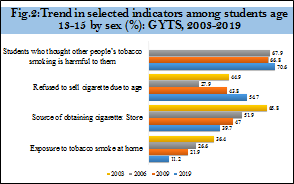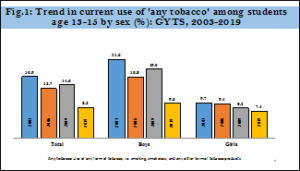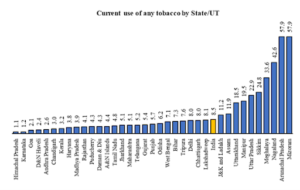In news- Recently, the Union Minister for Health and Family Welfare presided over the release of National Fact Sheet Global Youth Tobacco Survey (GYTS-4), India, 2019.
About Global Youth Tobacco Survey-4
- The 4th survey was conducted in 2019 by the International Institute for Population Sciences (IIPS) under the Ministry of Health and Family Welfare (MoHFW).
- The survey was designed to produce national estimates of tobacco use among school going children aged 13-15 years at the state level and Union Territory (UT) by sex, location of school (rural-urban), and management of school (public-private).
- The first three rounds of GYTS were conducted in 2003, 2006 and 2009.
- A total of 97,302 students from 987schools (Public-544; Private-443) participated in the survey.
- The objective of the survey was to provide information on tobacco use, cessation, second-hand smoke, access and availability, exposure to anti-tobacco information, awareness and receptivity to tobacco marketing, knowledge, and attitudes.
- The GYTS is an important tool to assist countries in supporting WHO MPOWER, a package of six evidence-based demand reduction measures contained in the WHO Framework Convention on Tobacco Control.
- WHO, spearheaded by the Tobacco Free Initiative (TFI), UNICEF and the Office on Smoking and Health at the Centres for Disease Control and Prevention (OSH-CDC), developed the Global Youth Tobacco Survey (GYTS)
Key findings of the survey
Tobacco use:
- Nearly one-fifth of the students aged 13-15 used any form of the tobacco product (smoking, smokeless, and any other form) in their life.
- Between the last two surveys, the current use declined by 42% (2009-2019).
- Prevalence of tobacco use among boys was 9.6% and among girls was 7.4%.
- The prevalence of smoking tobacco was 7.3%.
- In the case of smokeless tobacco products, the prevalence was 4.1%.
- Ever use of e-cigarette among the students was 2.8%.
- Use of any form of tobacco was higher among boys than girls.
- The current use of tobacco among students across the States/ UTs ranged from the highest in Arunachal Pradesh and Mizoram (58% each) to the lowest in Himachal Pradesh (1.1%) and Karnataka (1.2%).


Age of initiation of tobacco:
- 38% of cigarettes, 47% of bidi smokers and 52% of smokeless tobacco users initiated the use before their 10th birthday.
- The median age at initiation of cigarette and bidi smoking, and smokeless tobacco use were 11.5 years, 10.5 years and 9.9 years respectively.
Cessation:
- 2 in 10 current smokers tried to quit smoking in the past 12 months and another 2 in 10 students wanted to quit smoking now.
- 27%of current users of smokeless tobacco tried to quit using in past 12 months and another 25% wanted to quit now.
Second-hand smoke:
- 29.5% of the students were exposed to second-hand smoke (11.2% at home, 21.2% inside enclosed public places, 23.4 at outdoor public places).
Access & availability:
- 69% of current cigarette smokers and 78% of current bidi smokers bought cigarettes/bidis from a store, paan shop, street vendor or vending machine.
- Among the current smokers who bought cigarette/bidi, 45% of cigarette smokers and 47% of bidi smokers were not refused because of their age.
Media and anti-tobacco messages:
- 52% of students noticed anti-tobacco messages in the mass media.
- 18% of students noticed tobacco advertisements or promotions when visiting points of sale.
Knowledge & attitudes:
- 71% of students thought other people’s cigarette smoking is harmful to them.
- 58% of students favoured ban on smoking inside enclosed public places.
School policy:
- 85% of school heads were aware of COTPA, 2003.
- 83% of schools were aware of the policy to display ‘tobacco-free school’ board.
The State-wise tobacco consumption pattern was also brought out in the survey.

The International Institute for Population Sciences (IIPS)
The International Institute for Population Sciences (IIPS), Mumbai, formerly known as the Demographic Training and Research Centre (DTRC) till 1970, was established in July 1956 under the joint sponsorship of Sir Dorabji Tata Trust, the Government of India and the United Nations. It was declared as a ‘Deemed University’ on August 14, 1985, under Section 3 of the UGC Act, 1956 by the Ministry of Human Resource Development, Government of India
















